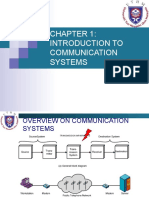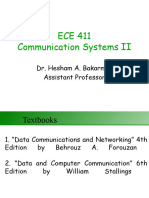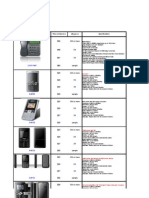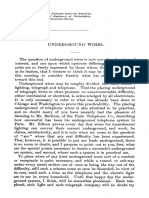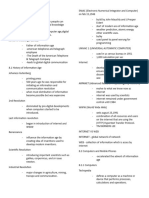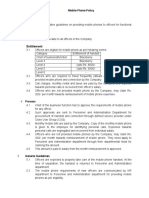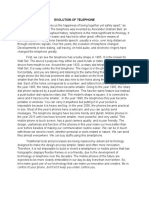EECS 307:
Communication systems
Week 1
Refik Caglar Kizilirmak
Nazarbayev University
�Telecommunications
Transmission of signals over a distance for the
purpose of communication.
The word telecommunication is a
compound of the Greek prefix tele, meaning
'far off', and communication, meaning 'to
transfer information'.
Telegraph, telephone, television etc.
�Telecommunications
Communication systems have 3 parts:
Transmitter
Physical Medium
Receiver
Give some examples of Telecommunication
systems?
Name the mediums for each.
�Some ancient technologies..
�Transmission with electricity
1831 Professor Joseph Henry, Albany, NY Ring a bell at a
distance by connecting and disconnecting wires.
May 24, 1844 -- Samuel Morse sends from Baltimore to
Washington, D.C. What hath God wrought.
Morse code
�Telegraph
1854 25,000 miles of telegraph wires have been
laid across the US.
Train schedules, weather, important news
1864 A telegraph line spans the entire continental
US
1866 Trans Atlantic telegraph
8 words a minute
Very costly
�The first transatlantic cable was laid
in 1858
Route of the cable from Canada to Ireland
Cyrus W. Field
�Today, undersea cable networks
(mostly optical fiber)
�Modern Electronic Communication
1893: Wireless telegraphy
1896: Radio.
1914: First North American transcontinental telephone calling
1927: Television.
1927: First commercial radio-telephone service, U.K.U.S.
1930: First experimental videophones
1934: First commercial radio-telephone service, U.S.Japan
1936: World's first public videophone network
1946: Limited capacity Mobile Telephone Service for automobiles
1956: Transatlantic telephone cable
1962: Commercial telecommunications satellite
1964: Fiber optical telecommunications
1965: First North American public videophone network
1969: Computer networking
1973: First modern-era mobile (cellular) phone
1981: First mobile (cellular) phone network
1982: SMTP email
1983: Internet.
1998: Mobile satellite hand-held phones
2003: VoIP Internet Telephony
�"If the presence of electricity can be made visible
in any part of the circuit, I see no reason why
intelligence may not be transmitted
instantaneously by electricity.
Samuel Morse
�Communication System
Communication involves the transmission of
information signal from one point to another
through a successive process.
�Communication System
Transmitter converts message signal (from
source of information) into a form of suitable
for transmission.
Received signal is corrupted by the noise and
other interferers.
Received signal is the corrupted version of
transmission signal.
Receiver has to reconstruct the original
message signal.
�Two Basic Modes of Communications
(according to Haykins book)
1) Broadcasting:
Single powerful transmitter and a numerous
receivers. Single message signal is transmitted
and received by all the receivers. One-way
transmission.
2) Point-to-Point:
Communication takes place over a link between
a signal transmitter and a receiver. Usually bidirectional.
�Primary Resources
Channel Bandwidth
Transmitted Power
Noise
�SNR
Signal-to-noise ratio, usually defined in dB.
dB is not a unit. It defines the ratio.
SNR = 10, SNR = 10 dB = 10*log10(10)
SNR = 100, SNR = 20 dB
SNR = 1000, SNR = 30 dB
�more on dB..
1 mW = 0 dBm
1000 mW = (0 + 30) 30 dBm
2000 mW = 10log1000 + 10log2 = (30 + 3)dBm
500 mW = 10log1000 10log2 = (30-3) dBm
1000 mW = 1 W = 0 dBW
[dBm] = [dBW] + 30
�Sources of Information
Source of information is characterized in
terms of a signal that carriers the information.
Signal is electrical current or voltage that
conveys information. It can be onedimensional (audio, computer data) or twodimensional (picture, image, video).
�Speech signal
Human speech ranges from a few hundred Hz
to a thousand Hz.
Soprano 250 Hz 1KHz
Contralto 200 Hz 700 Hz
Baritone 110 Hz 425 Hz
Bass 80 Hz 350 Hz
�Music Signal
Human ear can hear frequencies from 20 Hz
to 15 KHz.
Flute 250 Hz 2.5 Khz
Piccolo 630 Hz 5 Khz
Percussion 260 Hz 3.5 KHz
http://www.falstad.com/fourier/
�Communication Network
OSI model composed of seven layers. We will
focus on Physical layer.
�Communication Channels
Transmission of information in the physical
layer is accomplished in the physical layer by
means of communication channel.
1) Guided propagation (telephone lines, coaxial
cables, optical fibers)
2) Free propagation (wireless broadcast
channels, mobile communications, satellite )
�Communication Channel
(Abstract Model)
�A Channel can be..
Linear or non-linear: wireless radio channel is
linear, satellite channel is non-linear
Time-invariant or time-varying: fiber optic is
time-invariant, whereas mobile radio is time
varying
Frequency selective or time-selective: mobile
channels can be both frequency and time
selective
�Linear vs. Non-linear
Mathematically if a system satisfies
superposition (scaling and additivity) property,
it is called linear.
Ex:
Scaling property
x
linear
y
4.x
y = 4x
non-linear
x
We will talk more about linear systems.
4.x+2
y = 4x+2
�Time-invariant vs. time-varying
A system is called time invariant, if a time shift
in the input causes the same time shift at the
output.
x(t)
x(t-t0)
y(t)
y(t-t0)
We will talk more about time invariance when we talk about linear-time-invariant (LTI) systems.
�Time selectivity vs. Frequency
selectivity
Frequency selectivity (multipath fading).
Time selectivity (signal amplitude can fade
randomly due to scattering and moving
objects.)
Concept of fading will be discussed at the end of the class.
�Modulation Process
Transmitter modifies the message signal into a
form suitable for transmission over the
channel.
This modification is known as modulation,
which involves varying some parameters of
the carrier signal.
Receiver reconstructs the message signal from
the transmitted waveform. This process is
called demodulation.
�Classification of modulation schemes
(according to Haykins book)
1) Continuous-wave modulation
sine wave carrier is used.
Amplitude modulation (AM)
Phase modulation (PM)
Frequency modulation (FM)
2) Pulse-wave modulation
Sequence of pulses are used as carrier
Pulse amplitude modulation (PAM)
Pulse duration/width/length modulation
(PDM/PWM/PLM)
Pulse position/place modulation (PPM)
�CW Modulation
A message can be modulated on amplitude,
frequency, phase or combination of these.
Message signal
Carrier (sine wave) = Asin(2ft+)
Modulated wave (AM)
Modulated wave (FM)
�Pulse-wave modulation
Sequence of pulses are used to modulate the
message.
Message signal
Modulated wave (PAM)
Modulated wave (PDM/PWM/PLM)
Modulated wave (PPM)
Modulated wave (PCM)
�Multiplexing
Multiplexing is the process of combining
several message signals for their simultaneous
transmission over the same channel.
�Multiplexing
Frequency division multiplexing (FDM)
Time division multiplexing (TDM)
Code division multiplexing (CDM)
Wavelength division multiplexing (WDM) is
form FDM since wavelength is reciprocal with
frequency.
�Analog and Digital Communication
Analog communication is simple in conceptual
terms. Analog circuit design can be
challenging to deal with the non-linear
distortions.
Digital communication provides both reliable
and efficient transmission.
�Why do we still study analog
communications?
It has started all analog. It motivates other
digital communications.
Still, there exist analog radio/television and
some military radios. We need to understand
how they work.
Analog devices are more efficient (in terms of
power consumption) than digital devices.
Very-low-power dictates the use of analog.
�Shannons Information Capacity
Formula
Channel Bandwidth
Transmitted Power
Noise
C: capacity (bit/sec)
B: bandwidth (Hz)
S/N : signal-to-noise ratio (SNR)
Claude Shannon
�Shannons Information Capacity
Formula
For the same capacity, you can reduce the
signal power by increasing the bandwidth.
Capacity is proportional to the bandwidth and
the logarithm of SNR.
It doesnt tell you how to design a system, but
it is very useful to compare the modulation
schemes.







